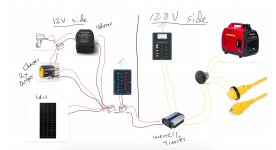I purchased an old houseboat recently and want to redo the electrical to make it more modern. The boat will be docked in a slip with 120v 30 amp. Would you please give me any suggestions or errors in my proposed setup?
On the 12 Volt side -
- A dedicated battery on the outboard motor. The alternator on the outboard will charge the start battery and then once charged the isolator will send extra current to the house batteries to charge
- A dual output marine charger to charge both the motor battery and house battery
- Solar panels/charger that will go directly to the house batteries to add capacity while on the water
On the 120v side
- An input of either shore power or generator depending on the situation
- An inverter transfer switch with 30amp AC passthrough to keep the 120v side live all the time
I will also be wiring the battery charger to work only on when shore/generator is present so it doesn't loop when on the inverter.

On the 12 Volt side -
- A dedicated battery on the outboard motor. The alternator on the outboard will charge the start battery and then once charged the isolator will send extra current to the house batteries to charge
- A dual output marine charger to charge both the motor battery and house battery
- Solar panels/charger that will go directly to the house batteries to add capacity while on the water
On the 120v side
- An input of either shore power or generator depending on the situation
- An inverter transfer switch with 30amp AC passthrough to keep the 120v side live all the time
I will also be wiring the battery charger to work only on when shore/generator is present so it doesn't loop when on the inverter.





















